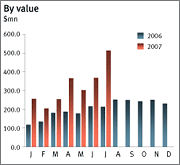 When I read about the report The "China Sourcing Report: Solar Panels" that shows majority of suppliers would decrease or keep prices stable, although the current polysilicon shortage is expected to continue until 2009, I was a bit surprised. I knew that China has major solar panel manufacturing capability but unaware of the numbers. I think it is a good report for anyone who is interested in Solar Energy field.
When I read about the report The "China Sourcing Report: Solar Panels" that shows majority of suppliers would decrease or keep prices stable, although the current polysilicon shortage is expected to continue until 2009, I was a bit surprised. I knew that China has major solar panel manufacturing capability but unaware of the numbers. I think it is a good report for anyone who is interested in Solar Energy field.The EU remains the primary export destination of China-made solar panels, followed by Asia and North America. Demand comes mainly from Germany, Spain, Japan, Belgium and the US, which together absorb more than 60 percent of exports. Combined shipments to these countries exceeded US$1.5 billion in 2006.
China has secured its position as one of the largest solar panel manufacturers in the world, with production soaring at impressive rates in the past several years.
The country turned out 460MW of photovoltaic modules in 2006. Exports were estimated to account for 90 percent of output, although exact figures are not available. Solar panel shipments are counted together with PV cells, LEDs and photosensitive semiconductor devices.
Growth projections for 2007 are quite modest, with output placed at 565 to 570MW. This leaves a significant portion of capacity underutilized, since the industry's manufacturing capability is expected to reach 2,000MW this year.
The insufficient supply of solar cells worldwide continues to be the main factor hindering China's even higher production of PV panels. The shortage stems from the inability of polysilicon suppliers to meet the huge demand for their product, which is the main raw material for solar cells and wafers. The supply situation is expected to improve, albeit gradually, as more facilities in the upstream industries become operational.
Despite the shortage, outlook in the solar panels industry remains generally bright. More makers are entering the line, as evidenced by the 17 percent growth in the supplier base. Furthermore, companies are investing in manufacturing systems that will enable them to make solar cells and wafers in-house. Others are expanding into PV power application products where silicon cells do not account for a significant portion of outlay.
The following are some of the key trends we see in China's solar panels industry:
| • | Overall capacity will continue to grow in coming months as suppliers prepare for the anticipated surge in domestic and overseas demand. Expansion, however, will average only 20 percent, as production capability at many companies remains mostly untouched. |
| • | Prices will remain relatively stable for the next six months despite a polysilicon supply gap. Most makers will opt to absorb additional costs, if any, and keep adjustments within 10 percent to boost sales and strengthen their foothold on a particular market. |
| • | Suppliers will continue to target the EU, focusing on countries such as Spain and France where the use of PV technology is growing. Consequently, export growth will remain strong, despite the drop in demand from Germany, currently the largest market for China-made solar panels. |
| • | With the shortage in polysilicon projected to continue for the next two years, makers are gearing R&D efforts toward thinner wafers or cells to minimize the use of the material in PV modules. |
This report covers the three types of solar panels produced in China. In the Products & Prices section, mono- and polycrystalline, and amorphous panels are described in terms of the solar cell they use. The key factors affecting pricing and market positioning are discussed here as well.
No comments:
Post a Comment